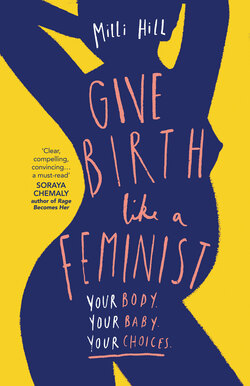Читать книгу Give Birth Like a Feminist - Милли Хилл - Страница 17
‘Re-centering me as the decision maker’: love and loss
ОглавлениеAttitudes and practices like these of Donna’s NICU staff are usually well meant, but often so deeply ingrained that they are beyond everyday awareness and rarely analysed or reconsidered. They are another part of our ‘allowed/not allowed’ birth culture. We know that, most often, health professionals have their patient’s best interests, and in particular safety, uppermost in their minds. To a clinician, everybody getting out of birth alive is the greatest priority. They have been trained to view every aspect of the experience through the framework of safety and risk, and this can sometimes be the justification for the over-medicalisation of birth or even for treatment lacking in empathy or compassion: ‘There simply wasn’t time.’ It’s interesting, therefore, to look at what happens to women when these safety concerns are completely removed, in that terrible scenario of baby loss.
‘Attitudes to stillbirth have improved a lot in recent times,’ Mel Scott, from the charity Finley’s Footprints, tells me. ‘Up until the past decade or so, babies who had died tended to be whisked off immediately or after just a few minutes. I still get messages from mums who lost their baby twenty years ago, who didn’t see them, hold them, name them, and don’t know where they are buried. And they have never forgotten, never got over it, and always regret not having that time. Although there have been some great improvements, it’s still the case that most parents don’t realise they have choices they can make about how they welcome their baby, or how they spend their time together, or where their baby goes.’
Natalie Lennard, whose son Evan was stillborn in 2013, had to fight for permission to give birth to him at home, even though he had a condition – Potter’s Syndrome – that meant there was absolutely nothing a hospital could have done to save him.[41] Hospital protocol was to end the pregnancy via an in-utero injection and induce the birth under epidural – choosing not to do this was a highly unusual and counter-cultural choice. With the support of Virginia Howes, an independent midwife, Natalie finally got permission to birth at home, at term, a triumphant and positive experience for her in spite of her loss: ‘His nose, ankles and wrists were squashed from having no fluid around him in the womb but otherwise he was my simply perfect baby. How could I have ever wanted him whisked away, cleaned and wrapped? No way, holding his bloody birthy beautiful body in my arms was the best part of all!’ Natalie is passionate that it was the support she received from her midwife that made truly informed choice possible; she was ‘the only character who stood alone from any party, and kept re-centring me as the decision-maker’.
Natalie goes on to say, ‘I joined a group on Facebook for Potter’s Syndrome and every few months a new woman joins from somewhere in the world, whose baby will have been diagnosed with exactly what Evan had, and sometimes she terminates within a couple of days because in their words, the “doctor thought it best”. Those women were never even given a choice, they probably didn’t think they had one. It would have been hard enough for me even with my own determination, but these women have no one to play the role of angelic devil’s advocate … Virginia’s attitude is nothing short of revolutionary, the future of all health care.’
Currently, a revolutionary attitude, and, if possible, a ‘Virginia’ for back-up, is required all round if you want to birth your baby, from your body, where you want, and how you want. Elective caesarean? This might require persistence: a report from the charity Birthrights in August 2018[42] highlighted that, in spite of UK NICE guidelines supporting a woman’s right to choose and be supported in this option, 15 per cent of trusts have an explicitly stated policy not to offer it, while a further 47 per cent were unclear as to whether a woman requesting a surgical birth would actually get one. The reasons for elective or maternal request caesarean are complex,[43] but in many cases requesting surgery is an attempt to take control over bodily autonomy, often after a previous birth experience where this was felt to be completely lost: ‘I chose an elective for both physical and psychological reasons,’ the journalist Natasha Pearlman writes. ‘The thought of surgery terrified me, to be honest, but not as much as giving birth naturally again.’[44] Autonomy is also a factor for women who have a history of sexual abuse: ‘I chose caesarean because it felt like, in terms of my history, it would be safer, more predictable. I didn’t want anything to happen, in particular involving physical touch, where I might feel out of control as I felt this would be very triggering,’ Lindsay, who had elective surgery in Australia for both her babies, told me. Maternal request caesarean forces us to ask questions about why some women would rather have major surgery than experience modern childbirth, and until at least some of those questions are addressed and resolved, there should be no barriers for the small percentage of women who request a birth in theatre.
